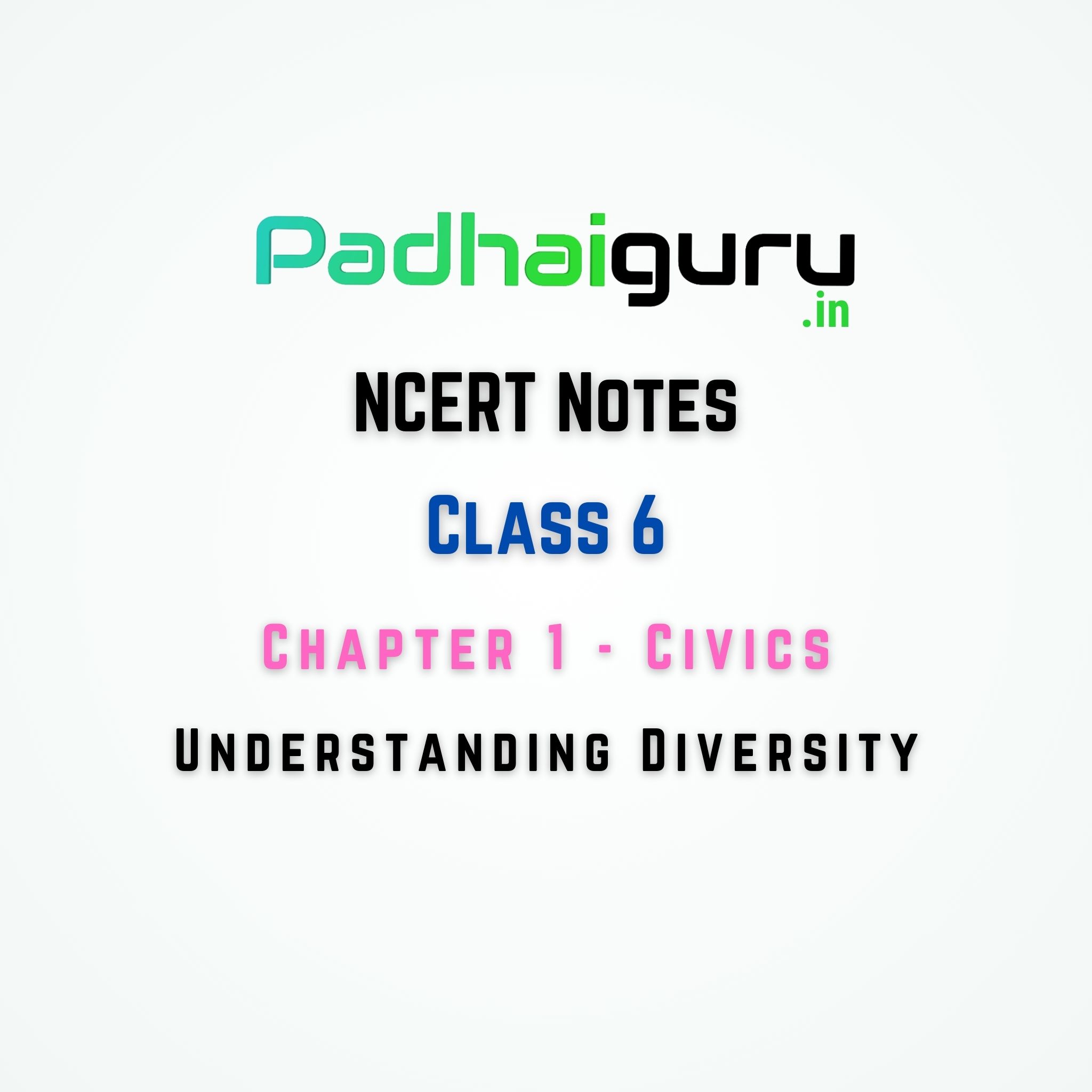01. Understanding Diversity Class 6 NCERT Notes of Chapter 1 Social Science – Civics

Welcome to Understanding Diversity Class 6 NCERT Notes of Chapter 1 Social Science – Civics specially created by padhaiguru.in.
Introduction
Human interactions are a blend of both similarities and differences, creating a fascinating tapestry of connections. Friendships that form between individuals from diverse backgrounds offer a unique lens through which to understand the complexities of the world. The captivating story of Samir Ek and Samir Do serves as a testament to the potential for profound friendships to flourish despite pronounced dissimilarities.
Differences Between Samir Ek and Samir Do
Language:
- Linguistic divide, communication barriers
- Samir Ek’s comfort with English contrasts sharply with Samir Do’s proficiency in Hindi.
- Despite this linguistic divide, their communication transcended language barriers.
Religious Background:
- Religious affiliations, hindrance to connection
- Samir Ek identifies as Hindu, while Samir Do practices Islam.
- Their distinct religious affiliations did not hinder their ability to connect.
Occupation:
- Pursuit of education, different journeys
- Samir Ek’s pursuit of education represents the path of formal learning.
- Samir Do’s occupation involves selling newspapers, leading him down a different journey.
Overcoming Differences for Friendship
Amid these disparities, Samir Ek and Samir Do managed to foster a profound friendship that transcended boundaries:
- Shared aspects, like their names, acted as bridges unifying their worlds.
- Both individuals showcased a willingness to understand and appreciate each other’s cultural contexts.
- The strength of their friendship surpassed language and religious barriers, revealing the potential for unity despite differences.
Festivals Celebrated by Samir Ek and Samir Do
The festivals they celebrate reflect the rich tapestry of their cultural backgrounds:
- Samir Ek actively participates in Hindu festivals like Diwali, Holi, and Raksha Bandhan.
- Samir Do observes Islamic traditions through his engagement in Eid and Ramadan.
Personal Experience of Making Friends
Personal anecdotes often mirror the themes of friendship and diversity, highlighting how individuals forge connections that transcend societal boundaries. Narrating a story of forming a friendship with someone of contrasting attributes emphasizes the universal nature of human connections.
Diversity vs. Inequality
Diversity:
Diversity stands as an inherent trait of human society, encompassing a spectrum of differences that contribute to the vibrancy of our existence. It celebrates distinct languages, foods, festivals, stories, and cultural practices, forming a beautiful tapestry of human experiences and identities.
Inequality:
On the contrary, inequality arises when disparities in resources, opportunities, and societal treatment become pronounced. It underscores systemic challenges that hinder equitable access to education, healthcare, and economic opportunities, perpetuating imbalances within society.
Diversity’s Enriching Role
Embracing diversity holds the power to enrich our lives in various ways:
- Cultural Understanding: Exposure to diverse foods, languages, festivals, and stories nurtures cultural understanding, fostering tolerance and appreciation.
- Empathy and Perspective: Engaging with various perspectives broadens our worldview, cultivating empathy and recognizing the shared humanity that unites us.
Experiencing Diversity in India
India serves as a microcosm of the world’s cultures and traditions, vividly illustrating the richness of diversity:
- Cultural Tapestry: The myriad of languages, foods, festivals, and religions reflects India’s pluralistic heritage, offering an opportunity for collective learning and celebration.
- Historical and Geographical Influences: The interplay of history and geography has contributed to this vibrant diversity. India’s interactions with various civilizations and its diverse geographic regions have shaped its cultural mosaic.
Unity in Diversity
The notion of unity in diversity resonates strongly in India’s context:
- The Indian freedom movement exemplifies unity among diverse individuals united by a common goal.
- Nehru’s phrase underscores the harmony achieved through acknowledging and respecting differences, exemplifying how unity prevails amidst diversity.
Keywords and Definitions
- Diversity: The variety of differences in cultures, languages, traditions, and backgrounds that enrich the human experience.
- Inequality: The existence of disparities in resources, opportunities, and treatment that result in imbalances within society.
- Unity in Diversity: The harmonious coexistence of individuals from various backgrounds, emphasizing shared values while respecting differences.
10 FAQs on Diversity, Friendship, and Unity
Q: What does the story of Samir Ek and Samir Do teach us? A: The story highlights how friendships can flourish despite differences in language, religion, and background.
Q: How did Samir Ek and Samir Do overcome their differences? A: Shared aspects, understanding cultural contexts, and a willingness to connect bridged the gaps between them.
Q: What role do festivals play in fostering unity? A: Festivals celebrate diversity and offer opportunities for individuals from different backgrounds to come together.
Q: How does diversity enrich our lives? A: Exposure to different cultures broadens perspectives, promotes tolerance, and encourages empathy.
Q: What is the difference between diversity and inequality? A: Diversity celebrates differences, while inequality arises from disparities in resources and opportunities.
Q: How can embracing diversity promote cultural understanding? A: Engaging with diverse foods, languages, and traditions fosters appreciation and respect for different ways of life.
Q: What does “Unity in Diversity” mean? A: It signifies people’s ability to coexist harmoniously while celebrating their unique identities and backgrounds.
Q: How does the Indian freedom movement exemplify unity in diversity? A: Individuals from various backgrounds united against a common oppressor, recognizing their shared goal of freedom.
Q: Can diversity lead to conflict? A: While diversity can result in differing viewpoints, open communication and mutual understanding can mitigate conflicts.
Q: How can unity in diversity be promoted in modern society? A: Encouraging education about different cultures, fostering inclusive policies, and promoting dialogue can foster unity in diverse communities.
Conclusion
The marvel of diversity enriches our societies and lives: Collaboration, respect, and empathy are the cornerstones of transcending differences. India’s unity in diversity serves as a testament to the collective strength of a multicultural nation. It’s an affirmation that differences need not divide us but can be bridges to understanding and unity.
This was the end of ncert notes on Understanding Diversity class 6 chapter 1 Social Science – Civics.
For more information, refer to NCERT SOLUTIONS, NCERT NOTES, and NCERT BOOKS
